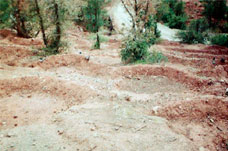| |
During Phase I, the Centres of Biodiversity Programme in Morocco was focused on the description of the main biodiversity elements of the oasis system and was illustrated by the case of the Aoufous Oasis. An oasis was defined by the programme as an area intensely cultivated in a desert or very arid environment.
The results were:
- The elaboration of a final report on the biological diversity in the Aoufous Oasis.
- The elaboration of an action plan to ensure biodiversity conservation and safeguard natural resources in the Aoufous Oasis.
- The elaboration of a guide on biological diversity in the Saharan areas of Morocco.
- The creation of a group of researchers and experts on the conservation of Saharan areas.
During Phase II, the activities were focused on the in situ conservation of threatened animal species, with pilot activities on birds of prey and wild boar, and on the conservation of natural habitats and the reintroduction of indigenous species.

Two nests were built for birds of prey, which had an impact on the rehabilitation of the ecosystem, the strengthening of the fauna heritage of the area, the reduction of the number of rats, which are harmful for agriculture and bring sickness, and the clearing of dead animals in the nature.
The second pilot activity was the regulation of the population of wild boar, which was increasing its size drastically through access to a lot of varied food in cultivated fields, making a lot of damage to them. 52 wild boars were captured through traps posted at the fields and transferred to other areas. This activity permitted to protect the fields against the wild boar and therefore improve the revenue of farmers, establish confidence with the population, reduce poaching of the wild boar and reduce risks of accidents caused by them.
The activities linked to the conservation of natural habitats and the reintroduction of indigenous species were the following:
- The transfer of the Barbary sheep and the introduction of the Cuvier's Gazelles in the Amassine Reserve.
- The rehabilitation of the Amassine and Takherkhort reserves, through the building and extension of a barrier for the reserves and the alimentation and adduction of water in the reserves.
- The plantation of 15 ha of carob trees in the Takherkhort Reserve, which help to fight against erosion.
|


